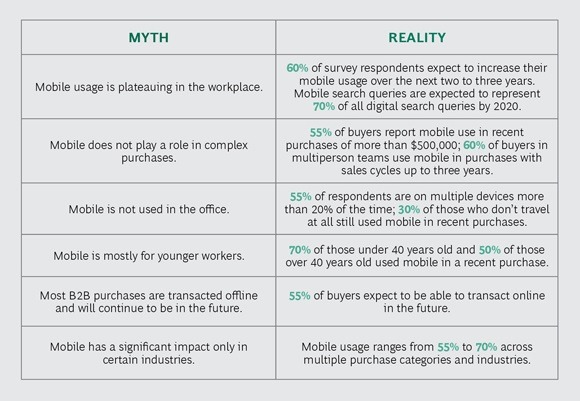Every B2B marketer should be looking at Google Analytics regularly. Specifically, Audience/Mobile/Overview. Look at the last 3 months compared to the previous year – we’ll bet doughnuts to dollars that the percentage of mobile users to your site has increased significantly. The big question is, did they explore your website and contact you, or did they leave?
New research from Boston Consulting Group verifies what digital marketing agencies have been advising their B2B and B2C clients to do for years: optimize your website for mobile devices, regardless of what business you’re in. BCG’s research shows that for those B2B businesses who have already optimized their websites, “mobile is already driving, or influencing, an average of more than 40% of their revenue – in industries that traditionally have depended much more on sales than marketing to generate revenue. Mobile speeds up time to purchase, particularly in more complex transactions, and a positive mobile experience increases repurchase rates.”
While many B2B purchases cannot be made on mobile devices, early purchase research is definitely carried out on phones and tablets, which leads to calls and contact forms that start the sales process. Aggressive companies have already arrived at this conclusion and have optimized their sites for tablets and phones, knowing that mobile plays a big role in formulating intent to purchase.
The bottom line: If your company is moving slowly or not at all in optimizing your website for mobile users, you’re going to lose market share to competitors who have.
The New B2B Buyer is mobile.
It’s all about the new B2B buyer and the digital marketing funnel. The new generation of business owners and executives don’t care to speak to a salesperson until they’re ready – or almost ready – to buy. This new set of buyers expect the same features on their phones as they do on a B2C website – a smooth user experience. This younger, tech-savvy user is typically the one performing early research which eventually gets passed on to the CEO, CFO, CMO, CTO, etc. – the executive or owner with the power to make the purchase decision.
Boston Consulting Group analyzed Google search query trends, surveyed nearly 3200 B2B buyers, and conducted in-depth interviews for this study, in which they learned:
- The use of mobile is playing a central and critical role with buyers, especially in the early stages of research
- Overall mobile device usage surpassed desktop usage in 2016 and is spilling over into the B2B workplace
- Mobile use is blurring the lines between play and work, as more employees stay productive when they’re away from their desks
- 80% of B2B buyers use mobile devices at work and more than 60% reported that mobile played a significant role in a recent purchase decision
- Google reports that 50% of B2B queries are now made on smartphones
- Forrester Research projects that B2B e-commerce will exceed 12% of all B2B revenue by 2020

Mobile myths and realities from research conducted by Boston Consulting Group.
Website mobile optimization speeds sales.
Business websites optimized for mobile are already seeing higher engagement on their websites and higher revenue shares driven or influenced by mobile. The BCG research also shows that mobile optimization speeds sales, which accelerates revenue and reduces costs. An optimized website offers a better user experience which strengthens brand loyalty, leading to repeat sales.
How to capture mobile users for your business.
The sooner your company embraces mobile usability the stronger your market position will be. To begin:
- Talk with your customers and collect website usage data via Google Analytics and other platforms to understand your customers’ purchase behaviors and the role that mobile plays/played in their purchase decisions.
- Mobile should be given equal emphasis with your desktop experience. Start by designing a responsive website which adapts to any screen size. If you’re still pushing the desktop site to mobile users, chances are they’ll bounce from your site within 2 seconds (literally).
- Design content which looks as great and is as easy to use on mobile devices as it is on desktops. This includes blog posts with images, white papers, tables, case studies, infographics, etc.
- Your advertising and marketing should be built to collect website user data for analysis. Once you have sufficient data, you can shape the path to purchase more efficiently.
Lastly, don’t get stuck in the “no one uses mobile to buy from my business” loop. Your analytics will certainly bear this out if you’re not delivering a mobile experience, as users will quickly abandon the site. At FunnelKake, we’ve heard this more times than we’d like to count, but once a mobile-ready website is delivering a fast and efficient user experience (including brief, easy to fill out forms), the user base grows, inquiries grow, and revenue grows. Getting out in front of your competitors with a mobile-friendly website is also a great opportunity to steal market share from your competitors who may be woefully behind in this area.
Be early and build brand awareness and loyalty among new B2B buyers and your business will reap the rewards.
Want to have a chat about how we can help your digital marketing efforts?

